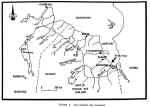|
1980, M.Sc., 232 pp.
ECOLOGY OF A SUBARCTIC COASTAL SYSTEM, NORTH POINT,
JAMES BAY, ONTARIO
Clarke, K.E.,
 This
interdisciplinary study describes an emergent subarctic coast in terms of
interactions between sediments, vegetational communities and
macrobenthos. The frequency and duration of tidal inundation exerts a
major influence on coastal ecology. Physico-chemical properties of the , I
sediments are highly intercorrelated along the low elevational gradient (1.0
m/km), and there exist well developed sequences of landward fining
in grain size, organic carbon content and pH. The electrical
conductivity of the salt marsh sediments shows a general landward decrease.
During the summer, climatic conditions strongly influence the chemical
properties "of the sediments
in the upper marsh. In 1978, which was a relatively wet year, the electrical
conductivity of the upper marsh sediments decreased
over the summer months. This
interdisciplinary study describes an emergent subarctic coast in terms of
interactions between sediments, vegetational communities and
macrobenthos. The frequency and duration of tidal inundation exerts a
major influence on coastal ecology. Physico-chemical properties of the , I
sediments are highly intercorrelated along the low elevational gradient (1.0
m/km), and there exist well developed sequences of landward fining
in grain size, organic carbon content and pH. The electrical
conductivity of the salt marsh sediments shows a general landward decrease.
During the summer, climatic conditions strongly influence the chemical
properties "of the sediments
in the upper marsh. In 1978, which was a relatively wet year, the electrical
conductivity of the upper marsh sediments decreased
over the summer months.
Vegetational communities consist
of one or two dominant grass or sedge species which occur in broad bands
running parallel to the shoreline. Principle component analysis indicates that
the location of plant communities and the distribution of above-ground biomass
are determined by a complex of tide-related factors which include elevation,
clay content, organic carbon, electrical conductivity, pH and Eh of the
sediments. Maximum average above-ground biomass (613 grams dry weight 1 m2)
was recorded in a Carex subspathacea-Scirpus maritimus meadow which
receives fresh-water input from an upland marsh/fen system. The minimum
average biomass (97 g dry weight 1 m2) occurred in a Triglochin
maritima-Potentilla egedii community which contains evaporative salt pans.
The tidal environment, salt marsh
and coastal ponds contain characteristic macrobenthic assemblages which
consist of one or two widely distributed groups. The molluscs Macoma
balthica and Hydrobia minuta (totteni) are the dominant organisms
of the tidal environment. Maximum average densities (8,600 1 m2 and
8,320 1 m2 , respectively) are found in the shallow subtidal Zostera
marina beds. On the tidal flats, the average density of both groups
increases significantly (P < 0.001) over the summer. The peak period of Macoma
spat settlement occurs from mid to late July. Average shell length ranges
from less than 3 mm for spat (0+ year) to 12.0 mrn (8+ year).
Oligochaetes (family Naididae,
genus Paranais) numerically comprise
63 % of the salt marsh macrobenthos. Distributions are strongly
correlated with the electrical conductivity (r = -0.736) and organic carbon
content (r = 0.833) of the sediments. Dipteran larvae of the families
Chironomidae, I
He1eidae and Tipu1idae occur in densities of up to 5,500 1m2 in the
coastal ponds. Variable climatic conditions cause large annual fluctuations in
dipteran densities, and under unfavourab1e conditions more than one year is
spent in the larval stage.
Migratory Semipa1mated Sandpipers (Ca1idris Eusi11a)
feed on Hydrobia minuta and small size
classes (5 mm) of Macoma ba1thica on the tidal flat. Many feed in small
water-filled depressions. These 'wet' microhabitats contain Macoma densities
which are six times higher than adjacent 'dry' microhabitats. In the salt
marsh, shorebirds feed in the coastal ponds. Chironomid larvae comprise
greater than 90 % of the prey taken by Semi- pa1mated Sandpipers in this
habitat. Seasonal shifts in the pattern of habitat use by migratory shorebirds
are related to seasonal differences in the distribution of their invertebrate
prey.
This study has examined
ecological relationships in a young dynamic coastal system of James Bay.
Further studies of this nature might lead to
the formation of a model which could be used to predict the impact of
potential development on the relatively undisturbed wetlands of
southern James Bay, and the subarctic in general.
|